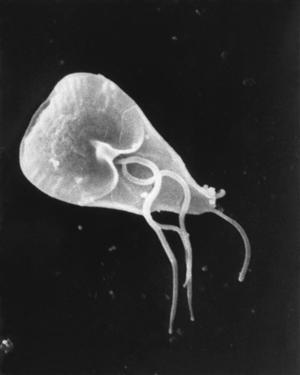Aquatic Organisms: Microorganisms
Microorganisms include members of the plant kingdom, protozoa, bacteria, and fungi. These organisms differ radically, and share only their small size; most are not visible without a microscope, though colonies of some can be seen with the naked eye.
Microorganisms are present in large quantities everywhere and can survive extreme physical and chemical conditions. Many microorganisms play foundational roles in aquatic ecosystems, capturing the sun’s energy through photosynthesis and, through their role in decomposition, releasing nutrients stored in organic tissue.
Bacteria
Some of the smallest and most ancient organisms on earth, bacteria are present in virtually every environment and are abundant in all aquatic systems. In rivers and streams, many of the bacteria wash in from the surrounding land, and their abundance can increase dramatically after a rainfall. The abundance of bacteria is typically in the millions per millilitre (mL), and in the hundreds of millions per millilitre in especially productive or polluted waters.
If conditions are right, bacteria reproduce extremely rapidly by simple division to produce very large numbers in a short period of time. Bacteria can be found suspended in the water, associated with decaying material (such as dead wood or leaves), or coating the surface of rocks, stones and sand grains as part of the biofilm (the slippery coating on hard surfaces in rivers). They can make up a large fraction of the living material in aquatic systems.
Bacteria display the greatest range in metabolic ability of any group of organisms. There are both autotrophic and heterotrophic bacteria. Heterotrophic bacteria are a crucial link in the decomposition of organic matter and the cycling of nutrients in aquatic systems.
Autotrophic bacteria are primary producers in aquatic systems as are true algae. For this reason, autotrophic bacteria (predominantly cyanobacteria) are often categorized as 'algae', though the organisms are by no means closely related. Cyanobacteria used to be mistakenly called 'blue-green algae'. Ecologically, much of what applies to algae is relevant to autotrophic bacteria.
Fungi
Fungi occur as single cells, and in filaments called hyphae. Most aquatic fungi are microscopic; those known as hyphomycetes are the most abundant and important. Fungi are heterotrophic, and, like heterotrophic bacteria, obtain their nutrition by secreting exoenzymes into their immediate environment, which break compounds down into simpler substances the fungi can absorb. Fungi are critical to the decomposition of plant matter in aquatic systems, because they are among the few organisms that can break down certain plant structural compounds such as cellulose and lignin.
Protozoa
Protozoa are microscopic, single-celled organisms that sometimes group together into colonies. There are both autotrophic and heterotrophic types of protozoa. Unlike bacteria and fungi, which absorb dissolved organic compounds from their environment, heterotrophic protozoa (such as the amoebas and Paramecium) consume other organisms such as algae, bacteria, or other protists. Together with other microorganisms, protozoa make up the biofilm coating sediments and hard surfaces on riverbeds, though some protozoa are free-swimming. Certain protozoa are parasites and cause diseases such as giardia (beaver fever).
Algae and Phytoplankton
Several groups of largely autotrophic protists are referred to as algae. Like the term 'microorganisms' it is an informal term, used for convenience to describe microorganisms that carry out photosynthesis; the cyanobacteria are often included as algae. Algae vary in size from microscopic to large colonies that can be considered macrophytes. Several types of algae—including phytoplankton—play an important role in supplying the energy at the base of many aquatic food webs.
Phytoplankton are small, microscopic plants that live suspended in the open water. Phytoplankton are generally more abundant in lakes than rivers, and are absent from fast-flowing streams, or where the rate at which the plants are washed downstream is greater than the rate at which they reproduce. Damming a river leads to still-water conditions more suitable for phytoplankton, and nuisance algal blooms may develop in reservoirs. Inputs of nutrients, including nitrogen and phosphorus, can also lead to algal blooms.
Phytoplankton can exist as single cells or in chains or colonies. Phytoplankton are direct food sources for many zooplankton and some fish, and are the base of the food web in deep waters. Phytoplankton vary in their requirements for nutrients, light, and other conditions. Waterbodies support a complex mixture of phytoplankton that can change markedly with environmental conditions. In rivers containing significant amounts of phytoplankton, the concentration of algal cells (number per unit volume) is generally highest when flows are lowest, while elevated suspended sediment loads during high flows can lead to reduced light and photosynthesis. Some phytoplankton can cause taste and odour problems in water, and anoxic conditions that can kill fish. Some cyanobacteria produce toxins lethal to various fish, wildlife, and domestic species.
Periphyton and Biofilm
Algae, bacteria, fungi, protozoa, and the breakdown products of dying cells form layers on submerged surfaces, including bottom sediment, rocks, submerged leaves and branches, and macrophytes. The term periphyton refers to a layer consisting mainly of algae, but the entire assemblage of layers is often known as biofilm. Periphyton is an important food source in shallow, stony rivers with adequate light penetration. Heterotrophic organisms, including larger invertebrates such as snails and insects, scrape the biofilm from surfaces, while some larger animals, such as fish, also feed on biofilm. Biofilm can be important in absorbing or breaking down chemical contaminants as well. Seasonal changes in the abundance of periphyton reflect fluctuations in river discharge, as layers of algal cells build up in times of low or decreasing flow, and wash away during flood periods.









